The Corsair H150i Elite Capellix AIO Cooler Review: Go Big Or Go Home
by E. Fylladitakis on October 15, 2020 9:30 AM EST- Posted in
- Cases/Cooling/PSUs
- Corsair
- Water Cooling
- Liquid Cooling
- RGB
- iCUE
Testing Results, Maximum Fan Speed
As always, we'll start things off by testing things at full speed/performance. Our maximum speed testing is performed with both the fans and the pump powered via a 12V DC source. This input voltage should have the pump and fans matching the speed ratings of the manufacturer. According to Corsair’s specifications, the MagLev fans included with the H150i Elite Capellix should have a rotational speed of 2400 RPM. Our tachometer indicated that the fans were rotating at an average speed of 2370 RPM, very close to their rated specifications.
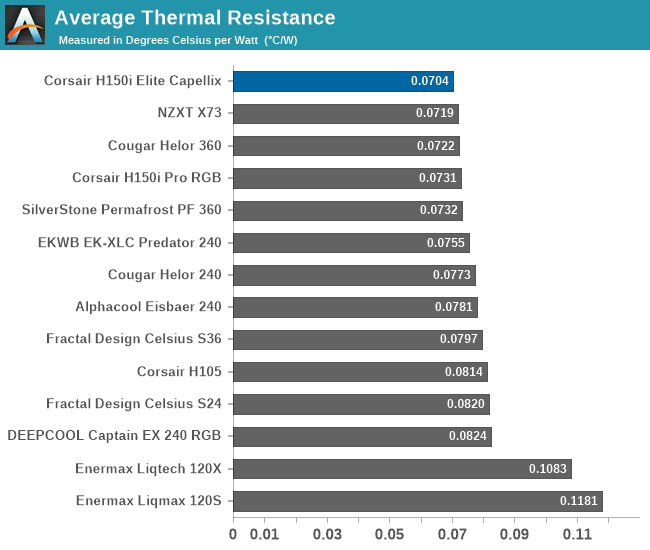

| Core Temperature, Constant Thermal Load (Max Fan Speed) |
The Corsair H150i Elite Capellix seems to be getting the best thermal performance out of every similarly sized AIO cooler that we have tested to this date, outperforming NZXT’s X73 by a whisker. The performance seems to be fairly stable across most of the load range, offering predictable performance regarding of the load, with the exception of very low loads where the temperature difference is far too small for appropriate heat transfer between the mediums.
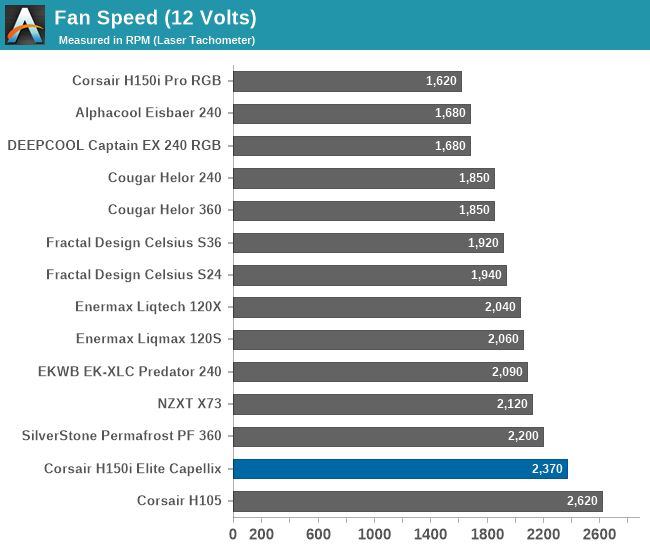
The average thermal resistance of 0.0704 °C/W is impressive but users need to keep in mind that this performance comes with the fans rotating at their maximum speed. With the powerful fans of the H150i Elite Capellix, this results to a sound pressure level of 43 dB(A), a relatively high figure for a CPU cooler.
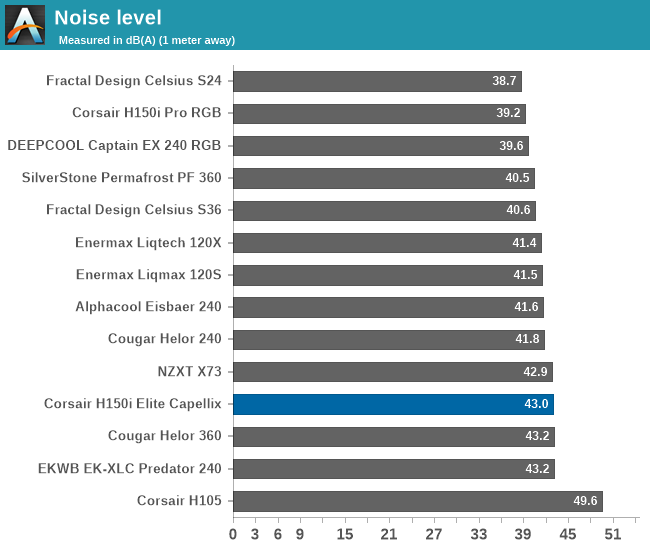
Testing Results, Low Fan Speed
Using a PWM voltage regulator, we reduced the speed of the fans manually down to half their rated speed. At this setting, the 120 mm MagLev fans of the H150i Elite Capellix rotate at 1220 RPM. Since the pump’s speed cannot be controlled directly, we had the Commander CORE module attached to a PC and set the pump to operate in its “Quiet” mode while testing.
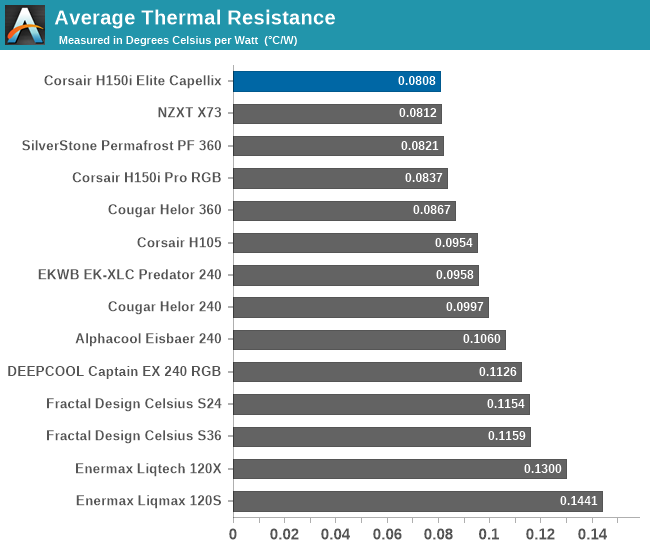

| Core Temperature, Constant Thermal Load (Low Fan Speed) |
When it comes to thermal resistance, Corsair’s latest AIO cooler initially seems to be slightly outperforming all of the 360 mm coolers that we have tested to this date. The average thermal resistance of 0.0808 °C/W is almost identical to the figures we received from the recently released NZXT X73, with Corsair’s MagLev fans giving the H150i Elite Capellix a small advantage in terms of acoustics.
But if one looks at just the thermal performance charts, other implementations with significantly slower fans, including Corsair’s older H150i Pro RGB, initially seem to be performing slightly worse. A closer look reveals that the better thermal performance is due to the quick fans of the H150i Elite Capellix, resulting to significantly higher noise levels. Setting the fans to operate even slower is likely to neutralize any thermal performance advantage that the cooler has.

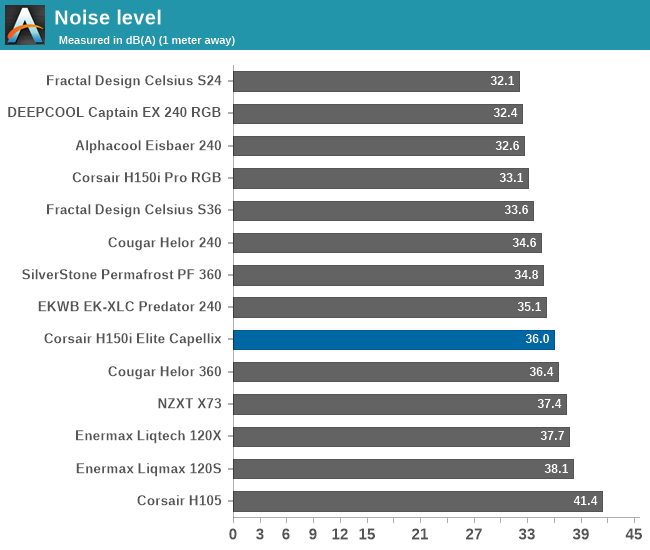
Thermal Resistance VS Sound Pressure Level
During our thermal resistance vs. sound pressure level test, we maintain a steady 100W thermal load and assess the overall performance of the coolers by taking multiple temperature and sound pressure level readings within the operating range of the stock cooling fans. The result is a graph that depicts the absolute thermal resistance of the cooler in comparison to the noise generated. For both the sound pressure level and absolute thermal resistance readings, lower figures are better.
This graph reveals interesting information regarding the overall performance of the H150i Elite Capellix. Although it does manage to get the best thermal performance out of every other similarly sized cooler, it can be seen that the older H150i Pro RGB actually outperforms it when taking the acoustics into account. This is because of the fast 2400 RPM fans that Corsair includes with the H150i Elite Capellix and our two-point testing methodology. Theoretically, the H150i Elite Capellix would perform identically or nearly identically with the H150i Pro RGB if both coolers were to share the same fans. It is also proof that the long and thin 360 mm radiator benefits very little from higher airflow, as its heat transfer surface is far too large to allow for significant temperature differences even if the airflow is low.


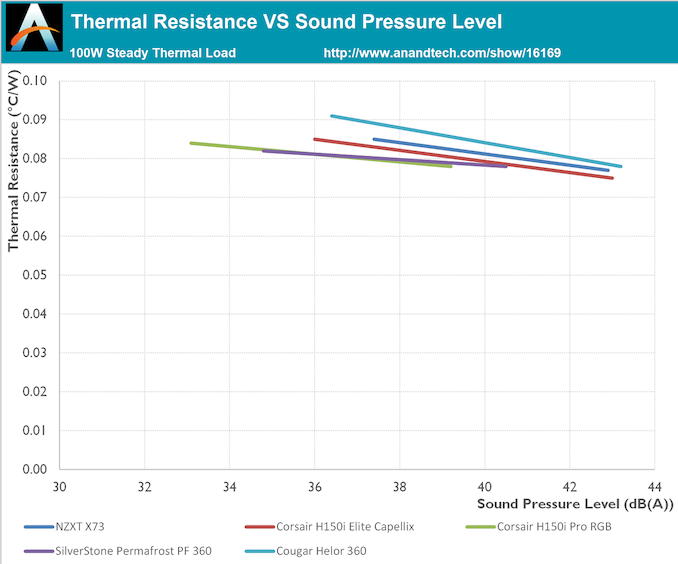








37 Comments
View All Comments
SirMaster - Sunday, October 25, 2020 - link
I mean my air cooled PC fans are never faster than 800rpm. I can't even tell if it's on or off from a few feet away.khanikun - Sunday, October 18, 2020 - link
A whisper is around 30 db. NZXT Kraken X63 280mm in reviews is around 30 db at low. So I'd say that's whisper quiet.willis936 - Thursday, October 15, 2020 - link
Not even Corsair's marketing speaks so highly about these fans. Magnetic bearings are not "magnetic levitation engines" (that would be the motor, which all fans have) and they are not new.They're awesome and they're cool to see in case fans, but the 1st page words leave a bad taste.
https://en.wikipedia.org/wiki/Magnetic_bearing
https://www.corsair.com/corsairmedia/sys_master/pr...
E.Fyll - Thursday, October 15, 2020 - link
From my point of view, the magnetic bearing is but a part of the engine that converts electrical energy to mechanical energy (airflow). You are probably referring to the engine as just the part that converts electrical energy to torque, neglecting the rest of the transmission system, which is not wrong but I would rather keep things simpler than that in my texts. I always classify fan engines based on their movement transmission system because everything else remains pretty much the same. You will find terms such as "ball-bearing engine" and "sleeve-bearing engine" frequently in my texts. The term "magnetic levitation engine" may not be entirely technically correct but definitely is better than "a 12V DC brushless motor with a magnetic levitation bearing axial transmission system" for the average person.Magnetic bearings may not be new by technological terms but they are just finding applications in low-cost retail market products, hence they are cutting-edge by the applicable definition of the term. There are many technologies that find their way into the retail market many decades after their initial discovery - that does not make them archaic, it only means that the conditions made their commercial exploitation applicable.
willis936 - Thursday, October 15, 2020 - link
These are fair points. Thanks for taking the time to respond.Pneumothorax - Thursday, October 15, 2020 - link
I’m currently running a NH-D15 on a 9900K. Am I getting any improvement with this besides just the aesthetics?Drkrieger01 - Thursday, October 15, 2020 - link
No. You'll may actually lose cooling capacity, as Linus found out (Linus Tech Tips). He did a review showing that big heatsinks like the Noctua NH-D15 outperform pretty much all AIO water coolers when it comes to heat soak (when the heatsink/radiator hit their dissipation limits). Granted, the margin is only a few degrees, but still. What you will get with an AIO water cooler is a slower increase/decrease in temperatures as the water works as an absorbing/transfer medium. The more water in the loop, the longer it takes to bring up the temperatures.Drkrieger01 - Thursday, October 15, 2020 - link
I should also say that, if AIO coolers would actually use a copper radiator, they would outperform something like the NH-D15. None of the AIO's use copper in their radiator, and I believe this is due to a patent being held by the main AIO manufacturer.imaheadcase - Thursday, October 15, 2020 - link
I don't think that would matter though, it still follows tubing back to the CPU, that itself is terrible at temp retention. Especially when they make them long on purpose for all case types they installed in.But yah i found its to much of a hassle to go all out with stuff like this, really AIO coolers for me now are just about looking better and working better in case for airflow than actual performance.
imaheadcase - Thursday, October 15, 2020 - link
on side note pet peeve, for whatever reason EVERY AIO cooler i have bought has never fit correctly in a case i've had..despite it showing it should before i bought it. Its mostly cosmetic things to change, like bending a small piece of metal, or something you won't notice with case cover on. But last one was a pain because after everything was installed in complete new build..it wouldn't power on. So did the normal check everything is connected, yep. I ended up finding out that radiator actually cut the USB cable connection front of case next to power button. So it was shorting out, all i had to do was unplug usb and booted up fine.That litte stupid problem would of been avoided if had correct specs..that was like 2 hours of trouble shooting. lol